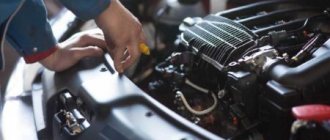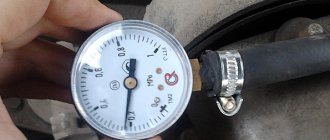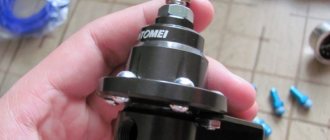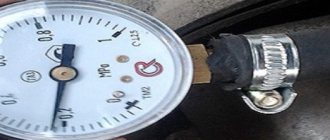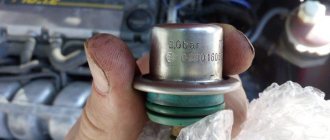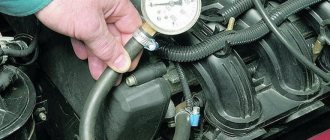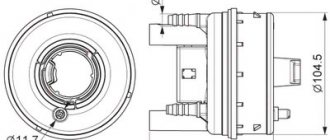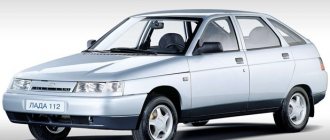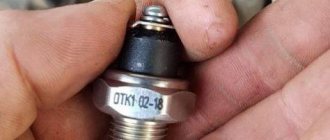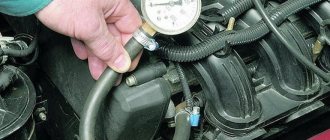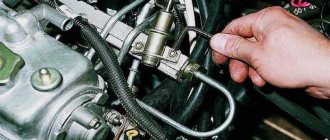The injector fuel pressure regulator is one of the internal combustion engine parts that maintains the required fuel pressure in the fuel injectors depending on the selected engine operating mode. The stability of the engine and the performance of the injectors directly depend on the proper functioning of the fuel pressure regulator.
Since the RTD is classified as a diaphragm valve, signs of a malfunctioning fuel pressure regulator and its failure can have a negative impact on engine performance. Carrying out regular diagnostics of the regulator, troubleshooting it and necessary repairs are procedures that every car owner needs to know about.
Where is the fuel pressure regulator located?
A diaphragm valve-regulator, which is subjected to fuel pressure on one side and spring force on the other, is used to more accurately dose fuel and maintain constant pressure in the system. A VAZ fuel pressure regulator of this type is installed in those systems that have a return line. In them it is located in the fuel rail. Less commonly, the part is installed in the fuel tank, but such systems do not have a return line. How the fuel pressure regulator works depending on its location is described below.
What pressure should be in the fuel system?
The pressure level in the fuel supply circuit depends on the design of the system. In cars where the RTD and the discharge tube - “return” - are located in the engine compartment, the pressure gauge should show 2.7 Bar. The upper and lower permissible limit is 2.7–3.0 Bar. If the measured values are outside the specified range, you should continue the diagnosis and find the cause of the problem. On many cars, including VAZ, the pressure regulator and the fuel return hose are located next to the fuel pump. The normal manifold pressure for such machines is 3.8 Bar, the maximum value is 4 Bar. If during the measurement process periodic pressure surges within 0.2 bar are observed, the primary strainer needs to be cleaned or replaced. Typically, it is installed in the gas tank along with an electric pump.
Location of the regulator in the fuel rail
One of the most common placement schemes: the VAZ fuel pressure regulator is located on the fuel rail. The principle of operation of the element is to pump fuel through the line from the fuel tank using a fuel pump. The regulator is under pressure from the fuel. The RTD itself consists of two separate cavities-chambers, separated by a membrane: a fuel chamber and a spring chamber. Through special inlet holes, fuel enters the regulator, which puts pressure on the membrane on one side; on the other hand, a spring and the pressure of the intake manifold presses on it. If the fuel exerts greater pressure than the spring force and inlet pressure, then the regulator opens, due to which part of the fuel is discharged into the “return”. Excess fuel is sent back to the fuel tank via the return line.
Location of the regulator in the fuel tank
The RTD is placed directly in the fuel tank in systems that do not have a return line. The advantage of such a system is the absence of an additional pipeline. The required volume of fuel is supplied directly from the tank, that is, excess fuel does not accumulate in the engine compartment, and accordingly, there is no need to send it back to the tank. Thanks to this design, the fuel does not overheat and evaporates less, which is an additional advantage.
A modern nozzle is a compact but complex device.
A modern nozzle is a compact but complex device.
A modern nozzle is a compact but complex device.
The level of care with which the specialists fine-tuned the diesel engine’s working process is evidenced by its low noise level. Thus, preliminary injection before the main dose significantly softened the ignition of the mixture - this alone made CR diesels more silent than their predecessors. CR diesel engines also have post-injection. Its role is auxiliary - to clean the particulate filter. An additional portion of fuel, without burning in the cylinders, enters the filter and heats it to temperatures at which the soot is completely burned out.
Electronic circuit for regulating fuel pressure
The fuel pressure in the system is adjusted using an electronic circuit, the design of which does not imply the presence of a mechanical regulator. The pressure in such systems is controlled by an electric fuel pump. The electronic control system installed in it records the voltage and regulates the volume of supplied fuel. The advantages of using a fuel pressure regulator sensor are maximum savings and reduced fuel heating.
Only a strictly limited amount of fuel is supplied to the engine injectors, necessary for the selected operating mode of the engine and the specific conditions of its operation. Excess pressure does not rise to a critical level due to the presence of a relief valve.
WE DIAGNOSE
There is a minimum of equipment without which it is unreasonable to start working. Diagnostics of electronic systems begins with reading fault codes, checking sensors and actuators. There are no special diesel scanners, there are universal ones, that is, for a wide range of cars, or dealer ones - for a specific brand. To study the signal from the device under test, you need an oscilloscope. But it is expensive; it is more profitable to buy a scanner with an additional oscilloscope function.
Fuel pressure is checked with pressure gauges. Low - mechanical, with a scale of up to 10 bar, and high - with a special device with adapters and a range of at least 2000 bar. And to measure the amount of fuel drained from the injectors, you need your own set.
The troubleshooting algorithm depends on the nature of the failure. If the engine does not start (electronic locks and forgotten secrets do not count), we check the integrity of the timing drive. If the starter rotates the crankshaft with force, this is not bad for the owner, but if without resistance, the repairmen will be happy: the work ahead will be expensive. After all, diesel engines are “plug-in” - when the timing drive is destroyed, the pistons bend the valves, and then whatever happens.
The main symptoms of fuel pressure regulator problems
When diagnosing the engine power system, it is necessary to take into account the signs of a malfunction of the fuel pressure regulator. The main symptoms associated with RTD problems are a decrease in engine power and its inability to reach the required speed. Signs of a malfunction of the fuel pressure regulator and, accordingly, the engine are as follows:
- The engine idles unsteadily and stalls.
- Fuel consumption increases, power decreases.
- The engine responds slowly to the accelerator pedal.
- When accelerating the car and when changing the throttle, jerks and dips appear.
- The car does not gain speed and does not accelerate.
The symptoms of a problem with the fuel pressure regulator on cars with gasoline internal combustion engines are similar to a failure of the fuel pump or its strainer. For this reason, the fuel pressure regulator is checked if any malfunctions in the engine fuel system are detected.
Simply put, when the above-described symptoms of engine malfunctions appear, the problem may be hidden not only in a breakdown of the relay, the fuel pump motor, or contamination of its grid, but also in the fuel pressure regulator.
Signs of sensor failure
In all cars produced after 2000, the RTD is integrated into the engine control unit and in case of any malfunction, a “Check” will light up on the dashboard. There are old diesel engines that are equipped with mechanical regulators; diagnostics of the elements is carried out as planned or after a malfunction of the internal combustion engine occurs. Characteristic symptoms of a faulty sensor:
- In addition to the “Check Engine” signal, the following error codes appear: P0190-P0194.
- A sharp decrease in internal combustion engine power, loss of traction, is often detected during overtaking; the car does not have the power to dynamically accelerate even up to 120 km/h.
- Excessive fuel consumption.
- The car starts poorly, regardless of whether the engine is warmed up or not.
- Diesel internal combustion engines are characterized by the appearance of dips at high speeds, when the engine does not respond to speed reduction.
RTD defects: spring
The main problem with the regulator is the weakening of the spring, which causes premature draining of fuel into the return line. This leads to starvation of the engine: it does not have enough fuel to operate at high speeds, when the accelerator pedal is pressed, or in transient modes. A faulty regulator spring causes low fuel pressure in the fuel rail, which leads to a decrease in engine power, problems with the ECU and unstable operation of the engine.
RTD contamination
Another malfunction of the regulator is its contamination and reduced throughput. In this case, the engine stalls regardless of which specific operating mode is selected. If the regulator is heavily contaminated, the pressure in the system increases sharply, and this can lead to fuel escaping through the sealing parts and joints. Vehicle manufacturers always consider the possibility that injector and fuel pump performance will deteriorate over time. This problem is solved by pumping more fuel into the fuel pump. Excess fuel increases pressure if it cannot return back to the return line.
Regulator jammed
The pressure regulator located in the fuel rail may begin to jam at certain intervals. Symptoms of such a problem include pressure drops in the system and jerking of the car. Another sign of a faulty fuel pressure regulator, which is no less common, is the banal wear of all parts: in other words, over time the valve completely exhausts its life. The service life of this engine element depends on the quality of the fuel, the presence of various impurities in it, the operating mode of the vehicle itself and many other factors.
Diagnostics and malfunctions of the fuel regulator
Fuel pressure regulator
The design of the fuel pressure regulator does not allow for repairs. In some cases, it is cleaned, but this procedure does not briefly extend the life of the device. If a breakdown is detected, most often the regulator is completely replaced with a new one. The main types of faults of this unit are:
- sagging or breakage of the working regulator spring;
- depressurization of the housing;
- mechanical wear of contact surfaces;
- corrosion of various surfaces;
- channel contamination.
Direct malfunctions can manifest themselves in three formats:
- jamming - the regulator does not operate every time it is needed, but periodically;
- incomplete closure - fuel is constantly drained into the tank (return line), regardless of pressure;
- jamming in the closed position - fuel does not drain under any parameters.
Signs of a malfunctioning fuel regulator have much in common with fuel pump failures and dirty filters. Thus, preliminary diagnosis can be made based on the following observations:
- Unstable operation and engine stopping in idle mode.
- Increased fuel consumption.
- Reduced motor power.
- Slow response to pressing the throttle pedal.
- Lack of smooth movement when accelerating the car, jerking is observed.
- The content of harmful components CO and CH in the exhaust increases significantly.
- The car does not accelerate.
The quality of the fuel has a significant impact on the service life of the fuel pressure regulator. You should also not neglect the timely replacement of fuel filters. Particular attention should be paid to the fuel regulator if the car has not been in use for a long time.
Causes of malfunctions
There are not many reasons why the fuel regulator fails. The element cannot be called ultra-reliable; it works, as they say, under wear and tear, and is very dependent on the quality of the fuel.
Causes of breakdowns:
- Marriage. This is not a common reason, but sometimes you come across defective products from domestic automakers. It is recommended to check the spare part before purchasing.
- Wear. Usually observed after 100-200 thousand kilometers. In the regulator, the membrane becomes less elastic, the pressure control valve gets stuck, and the spring becomes weaker.
- Bad fuel. Gasoline and diesel car engine fuel often contains too much moisture, debris, and foreign toxins. Water in fuel causes rusting of the metal parts of the regulator. Increasing over time, they interfere with its normal functioning and lead to weakening of the spring.
- The fuel filter is clogged. Garbage fractions in the fuel clog the system, including the RTD, and become clogged. This leads to spring wear and valve jamming.
On a note!
RTDs are usually not repaired, but replaced with a new one. But, if the cause of the breakdown is clogging, it can be cleaned.
Fuel pressure regulator diagnostics
In terms of its symptoms, a malfunction of the RTD is in many ways similar to malfunctions of the fuel filter or fuel pump. It is worth noting right away that if, during diagnostics of the fuel system, faults were found in the RTD, then the optimal way out of the situation would be to replace the fuel pressure regulator. This is explained by the fact that replacing individual parts, washing and cleaning the device will not return it to full functionality. Considering that the cost of the RTD is very affordable and acceptable, repairing the fuel pressure regulator is simply impractical.
You can diagnose the RTD yourself in one of the simplest and most effective ways: check the fuel pressure in the fuel system. This is done using a pressure gauge. It is measured with the engine idling; The pressure gauge is connected in parallel with the vacuum hose between the fitting and the fuel hose.
The measurements taken show pressure fluctuations in the system. It should increase, while being in the range from 0.3 to 0.7 Bar. If such indicators were not detected, then it is necessary to reconnect the fuel pressure regulator hose and reuse the pressure gauge. The fitting plug is unscrewed to measure the fuel pressure at the end of the fuel rail. The plug has a special sealing ring: you need to check it for integrity - it should not be elastic. If there are still defects on it, then it is changed either separately or together with the plug.
WE REPAIR
Restoring the pump's functionality can only be done by a specialized workshop with qualified personnel and diagnostic equipment. The cost of repairs is from 7 thousand rubles, then it depends on the complexity. In case of some damage, it is wiser to buy a new injection pump. The usual price, about 30 thousand rubles, will shock the tight-fisted diesel operator, which is why repaired or restored products are in use.
A CR diesel with high mileage is often impossible to start due to a malfunction of at least one of the injectors. Fuel leakage through its valve does not allow the pressure in the rail to rise to starting values. There is a special diagnostic kit to check the pressure at start-up. It includes a control pressure gauge, a pressure sensor, connection tubes, plugs instead of actuators and backflow measuring containers.
Fuel pressure regulator repair
After the diagnostics of the system is completed and the sealing ring is inspected, the umbrella is unscrewed from the fitting. You can unscrew it using the metal valve cap. The pressure gauge hose is then connected to the fitting, then the entire structure is secured using clamps. Pressure measurements are carried out only when the engine is running. Standard pressure readings should be 2.9-3.3 kg/cm2. Then the hose is carefully disconnected from the fuel pressure regulator, and the pressure gauge readings are recorded: the pressure should increase to 70 kPa from 20 kPa.
The fuel pressure regulator is changed if the readings remain too low or zero. Replacing this part is not difficult: you can do it yourself in a regular garage. Before starting the procedure, all pressure is released from the engine power system. To do this, unscrew the nut securing the fuel pipe, after which the bolts that secure the regulator itself to the fuel rail on most cars with injection engines are unscrewed.
Subsequently, the regulator fitting is carefully removed from the hole in the fuel rail, after which the RTD is completely dismantled. Before this, the fuel pipe is completely disconnected. The last stage is the installation of a new or working regulator into the ramp, after which the functionality and serviceability of the entire fuel system is checked using a pressure gauge.
Before installing a new fuel pressure regulator, experts recommend lubricating the O-rings with gasoline: this will make installation of the new part easier. A similar procedure is performed when replacing the o-rings themselves.
Today we’ll talk about the fuel pressure regulator, a mechanical device that is undeservedly deprived of attention.
It is popularly called a check valve or bypass valve. Usually, when there are problems with the engine such as: insufficient power, unstable idle, poor starting, engine jerking, they either pay attention to it last or simply ignore it. And in vain, because this is one of the most important elements in engine operation.
So we’ll talk about the “check valve”. The fuel pressure regulator (in everyday life, we all probably call it a “check valve” or “bypass valve”, because it transfers fuel back to the tank, in an amount depending on the engine operating mode), is installed on the fuel “rail” and is designed to maintain constant fuel pressure at the injector inlet at different engine operating modes and at different vacuum in the intake manifold. The regulator is a diaphragm valve. On one side, the membrane is acted upon by fuel pressure, and on the other, by spring force and air pressure from the intake manifold, to which the regulator is connected by a hose. The greater the absolute pressure (i.e., the lower the vacuum) of air in the intake manifold (i.e., the greater the load on the engine), the greater the fuel pressure. When the load on the engine decreases, when the fuel pressure exceeds the total force from the spring and air pressure, the regulator valve opens by a larger amount and excess fuel is returned through the drain line to the fuel tank. Figuratively speaking, the “check valve” serves only to maintain the same difference in pressure applied to the injector from the side of the intake manifold and from the side of the fuel line. ECU. “Does not hold”, which means its complete “openness”, that is, the fuel pumped by the fuel pump passes through the valve and fuel rail freely, almost nowhere and without being delayed by anything, and is quietly drained through the “return” line into the fuel tank. This condition causes low pressure in the fuel system. “Wedges”, “wedges” - in this case the valve works like a “drunk doorman in a restaurant”: “I want to let it in, but if I want to, I won’t let it in!” In this case, the fuel that gets into the fuel rail “sticks” into the valve, and since it has nowhere to go (and the pump at the back continues to create pressure), it begins to look for a way out... And sometimes, when the valve “wants”, it flows briskly into the tank along a completely open highway and no one can predict when all this will happen. “Dead” - of course, means: the valve in this state is like armored doors in a bank - it stands in the way of fuel and does not let it into the tank at all, under any circumstances. As a result, with the described malfunction, the pressure in the fuel system increases significantly. When the valve “does not hold,” the fuel pumped by the fuel pump circulates almost freely throughout the car. Fuel pump - fuel filter - fuel rail - and back to the tank. Let's imagine what is happening: there is low fuel pressure in the fuel rail, despite the fact that the fuel pump is working properly.
Why is a control valve needed?
The fuel supply system of most passenger cars requires continuous operation of an electric fuel pump. It constantly pumps gasoline into the fuel line and ramp, raising the pressure to the maximum (5–7 Bar depending on the brand of car). But such performance is needed only under increased load on the engine, when it develops high speeds and consumes a lot of fuel mixture. In normal mode, a fuel pressure at the injectors of 3–3.5 bar is sufficient.
The fuel pressure diaphragm valve, installed in the engine power system after the fuel pump, performs 3 main functions:
- Limits the fuel pressure in the line at low engine loads, dumping excess fuel back into the tank through a separate tube.
- When the gasoline consumption of the power unit increases, the return flow is partially or completely blocked by the regulator. In this way, the valve maintains the minimum pressure required for normal operation of the motor.
- Maintaining pressure for a long time after stopping the power unit.
Operating principle of RTD
The valve design and operating principle depend on the type of fuel system of a particular vehicle. There are 3 ways to supply gasoline from the tank to the injectors:
- The pump together with the regulator is installed inside the tank; fuel is supplied to the engine through one line.
- Gasoline is supplied through one tube and returned through another. The fuel system check valve is located on the distribution rail.
- The circuit without a mechanical regulator provides for electronic control of the fuel pump directly. The system contains a special sensor that registers pressure; the pump performance is regulated by the controller.
In the first case, the return flow is very short, since the valve and electric pump are interlocked into a single unit. The RTD, located immediately after the supercharger, dumps excess gasoline into the tank, and the required pressure is maintained throughout the supply line.
Reference. The first scheme with a regulator inside the gas tank has been implemented on all Russian-made VAZ cars.
The second option is used in most foreign cars. A valve built into the fuel rail allows excess fuel to flow into the return line leading to the tank. That is, 2 gasoline pipes are laid to the power unit.
There is no point in considering the third circuit - instead of a regulator, there is a sensor whose functionality is checked using a computer connected to the diagnostic connector.
A simple fuel pressure valve installed in the fuel pump unit consists of the following elements:
- cylindrical body with pipes for connecting the supply and return lines;
- a membrane connected to a locking rod;
- valve seat;
- spring.
The amount of pressure in the supply line depends on the elasticity of the spring . While most of the fuel goes into the cylinders (high load on the engine), it keeps the membrane and valve stem closed. When the crankshaft speed and gasoline consumption decrease, the pressure in the network increases, the spring compresses and the membrane opens the valve. The fuel begins to be discharged into the return line, and from there into the gas tank.
The fuel pressure regulator installed in the rail operates on a similar principle, but reacts faster to changes in load and gasoline consumption. This is facilitated by connecting an additional pipe of the element to the intake manifold. The higher the crankshaft speed and the vacuum on the spring side, the stronger the membrane presses the rod and closes the passage of fuel into the return line. When the load decreases and the speed drops, the vacuum decreases and the rod releases - the return flow opens and excess gasoline begins to be discharged into the tank.
Injector repair kit.
Already in the mode of cranking the crankshaft with the starter, the injection pump creates a starting pressure of 350–400 bar. At minimum idle speed - up to 500-600 bar, and at maximum load - up to 1300-1500 bar. There are pumps with pressure up to 2000 bar. Its value is set by a regulator located on the fuel injection pump housing or on the ramp and subordinate to the electronic engine control unit. When issuing commands, the ECU relies on signals from the rail pressure sensor.
Fuel is supplied through high-pressure pipes to the injectors, which open under the influence of an electrical signal. There are two design options - electromagnetic or with a piezoelectric element. The first one was not particularly fast at first, which forced the designers to look for an alternative. In a piezo injector, voltage is applied to a piezo crystal, which instantly expands. The spool compresses the spring, the injector needle opens the way for fuel - and it is injected into the combustion chamber. However, designers continue to improve electromagnetic devices - both options work successfully on modern engines.
Symptoms of element failure
During the operation of the car, a car owner may encounter two types of RTD failure:
- The pressure drop in the rail is below the permissible level - the regulator directs most of the fuel through the return line to the gas tank.
- Increase in pressure to maximum - the element does not allow fuel to flow into the return line.
Note. As a rule, the first malfunction is accompanied by a rapid drop in pressure in the system after the electric fuel pump is turned off.
It is quite simple to track the signs of the first malfunction - the power unit is sorely lacking fuel for normal operation in all modes. Symptoms appear as follows:
- cold starting is difficult, the engine runs extremely unstable until it warms up;
- “dips” during acceleration and jerks when moving uphill;
- the car often stalls at idle;
- Gasoline consumption per 100 km increases.
The increased fuel consumption is explained by the actions of the driver trying to compensate for the lack of fuel mixture by pressing the accelerator pedal. Driving in this mode is quite difficult - it is better to immediately check the fuel pressure regulator for functionality.
When the valve does not allow excess fuel to flow into the tank, the following consequences are observed:
- Due to too high pressure from the ramp side, the injectors begin to leak and fill the cylinders with pure gasoline, and not with the working air-fuel mixture.
- The engine is bad, it emits black smoke from the exhaust, and sometimes you can hear popping noises in the exhaust manifold. The reason is flashes of unburnt fuel.
- Consumption increases noticeably.
- Leaks may be observed at the joints of the fuel pipes, and a strong gasoline smell may be felt.
Practical experience shows that a lack of fuel mixture occurs more often than an excess. That is, the most common problem with an RTD is the draining of gasoline into the return pipe and tank.
On which cars is this problem most common?
The problem with code P0088 can occur on different machines, but there are always statistics on which brands this error occurs more often. Here is a list of some of them:
- Audi (Audi a4, Audi a6, Audi q7)
- BMW (BMW 535i)
- Chevrolet
- Citroen (Citroen Jumper)
- Dodge (Dodge Avenger, Dakota, Dart, Journey, Durango, Intrepid, Caliber, Caravan, Magnum, Neon, Nitro, Ram, Stratus, Charger, Challenger)
- Fiat
- Ford (Ford Galaxy, Mondeo, Ranger, Transit, F-150)
- Hover
- Hyundai (Hyundai Grand Starex, H1, Santa Fe, Sonata, Starex, ix55)
- Infiniti
- Isuzu
- Jeep (Jeep Grand Cherokee)
- Kia (Kia Bongo, Carnival, Mojave, Sid, Sorento, Sportage)
- Land Rover (Land Rover Discovery, Range Rover, Freelander)
- Mazda
- Mercedes (Mercedes Viano, Sprinter, gl350)
- Nissan (Nissan Patrol, Pathfinder)
- Opel (Opel Insignia)
- Peugeot (Peugeot Boxer)
- Renault
- Skoda (Skoda Octavia, Superb)
- Toyota
- Volkswagen (Volkswagen Caravel, Crafter, Passat, Tiguan, Touareg, Touran, Transporter)
- Volvo (Volvo s80, xc90)
- Gazelle Next
- PAZ Vector, Next
With fault code P0088, you can sometimes encounter other errors. The most common ones are: P0087, P0089, P0090, P0091, P0092, P0093, P0094.
Causes and Troubleshooting
If the above symptoms are detected, you should check the performance of the RTD using one of the suggested methods:
- measure the pressure in the fuel rail, its value should be at least 3 bar;
- find the return hose and carefully press it with pliers while the engine is running;
- disconnect the vacuum pipe leading from the manifold from the regulator.
The most reliable way is to measure with a pressure gauge. The device is connected to the fitting on the fuel rail, the test is performed with the engine running. If the pressure is below 3 Bar, additionally check the fuel pump - the unit may have lost performance. For diagnostics, you will need a tee with a pressure gauge embedded in the supply line. If the pump produces 3 Bar or more, change the RTD.
The reasons for valve failure look like this:
- the spring has lost its elasticity and allows the membrane to bypass fuel at low pressure;
- pollution with low-quality gasoline;
- rod jamming.
Due to the design features (the element body is rolled), repairing the fuel pressure regulator is impossible in most cases; the part will have to be replaced. The option of washing and blowing helps only with blockages inside the element.
Squeezing the return line is done at idle speed of the engine, preferably “cold”. If engine performance stabilizes, there is a problem with the RTD or pump. To determine the “culprit”, you will still need to measure the supply pressure. Try removing the vacuum tube from the manifold at higher speeds - if the valve has become unusable, the behavior of the power unit will not change.
